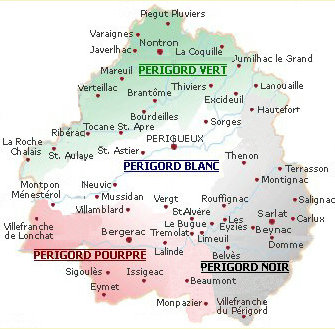In pre-revolutionary times, this area was the province of Périgord and was divided loosely into four sections, named green, white, purple and black.
The hilly Périgord Vert was originally a land of great forests and swamps, and although a lot of it has been cleared for farmland, a large part is now protected by the Parc Naturel Régional Périgord-Limousin.
Further south, near the town of Périgueux, is Périgord Blanc, reportedly named for the chalky limestone cliffs of the river valleys flowing westward across what was originally a shallow sea. Chalk mining was a big industry in the past and is practised even now.
Beyond that again is Périgord Pourpre, the flat, fertile land around Bergerac, famous for its orchards and vineyards, which are watered by the leisurely waters of the lower Dordogne river.
Over to the east is Périgord Noir, also heavily forested in the past, and priding itself now on its truffles. Here the upper Dordogne is joined by the Vézère river, whose valley is famous for its multitude of prehistoric sites, including Lascaux caves and the village of les Eyzies, home of the earliest specimens of modern humans.
The whole of Périgord is peppered with châteaux. The legend is that Saint Peter was carrying a sack of châteaux to distribute across France, but as he was passing Périgord the sack split and a great lot of them fell to to the ground, where they remain.
